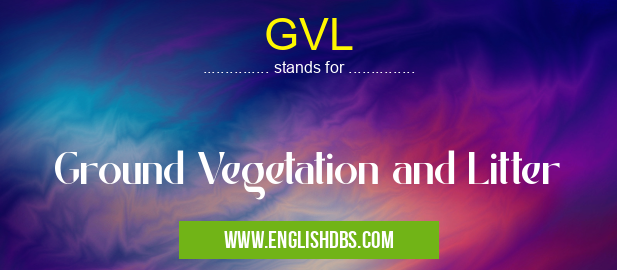What does GVL mean in UNCLASSIFIED
Ground Vegetation and Litter (GVL) refers to the layer of vegetation and organic matter that covers the soil surface in terrestrial ecosystems. It plays a crucial role in nutrient cycling, soil stability, and biodiversity.

GVL meaning in Unclassified in Miscellaneous
GVL mostly used in an acronym Unclassified in Category Miscellaneous that means Ground Vegetation and Litter
Shorthand: GVL,
Full Form: Ground Vegetation and Litter
For more information of "Ground Vegetation and Litter", see the section below.
Key Features of GVL
- Composition: GVL primarily consists of herbaceous plants, moss, lichens, and dead plant matter (litter).
- Depth: The depth of GVL varies depending on ecosystem type and environmental conditions, but it typically ranges from a few centimeters to several decimeters.
- Density: GVL density is influenced by factors such as plant growth, decomposition rates, and disturbance regimes.
Functions of GVL
- Nutrient Cycling: GVL decomposes and releases nutrients back into the soil, making them available for plant uptake.
- Soil Protection: The organic matter in GVL helps prevent soil erosion by binding soil particles together.
- Water Retention: GVL aids in water infiltration and retention, reducing runoff and soil moisture loss.
- Habitat: GVL provides habitat and shelter for a variety of organisms, including insects, small mammals, and amphibians.
- Carbon Storage: GVL accumulates and stores carbon, contributing to the global carbon balance.
Essential Questions and Answers on Ground Vegetation and Litter in "MISCELLANEOUS»UNFILED"
What is Ground Vegetation and Litter (GVL)?
Ground Vegetation and Litter (GVL) is a layer of vegetation and organic matter that covers the ground surface in a forest ecosystem. It consists of living and dead plants, including grasses, forbs, shrubs, downed logs, and decaying leaves. GVL plays a crucial role in forest ecology by supporting biodiversity, nutrient cycling, and soil health.
What is the importance of GVL in forest ecosystems?
GVL provides a habitat for various organisms, including insects, amphibians, and small mammals. It protects the soil from erosion, regulates moisture levels, and contributes to nutrient cycling by decomposing organic matter and releasing nutrients back into the soil. GVL also serves as a carbon sink, storing and sequestering carbon from the atmosphere.
How is GVL measured and monitored?
GVL is typically measured using a combination of field methods, including visual surveys, transects, and quadrats. Scientists assess the species composition, cover, and depth of GVL to understand its ecological characteristics and changes over time. Monitoring GVL is important for understanding the health and resilience of forest ecosystems.
What are the factors that influence GVL?
GVL is influenced by various factors, including tree canopy cover, soil type, climate, and land management practices. Tree canopy cover affects the amount of light reaching the ground surface, which in turn influences the growth of vegetation. Soil type affects nutrient availability and moisture retention, while climate influences temperature and precipitation patterns. Land management practices, such as logging or prescribed burns, can also impact GVL structure and composition.
What are the implications of changes in GVL for forest ecosystems?
Changes in GVL can have significant implications for forest ecosystems. Reduced GVL cover and diversity can lead to decreased biodiversity, impaired nutrient cycling, and increased soil erosion. Changes in GVL can also alter fire behavior and affect the ability of forests to adapt to climate change. Monitoring and managing GVL is crucial for maintaining the health and sustainability of forest ecosystems.
Final Words: GVL is an integral component of terrestrial ecosystems, fulfilling multiple ecological functions. Its composition, depth, and density vary across ecosystems, influencing nutrient cycling, soil stability, biodiversity, and carbon storage. Understanding the role of GVL is essential for effective ecosystem management and conservation.
